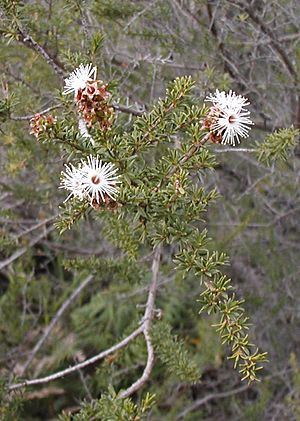Tick bush facts for kids
Quick facts for kids Tick bush |
|
|---|---|
 |
|
| Scientific classification | |
| Genus: |
Kunzea
|
| Species: |
ambigua
|
Kunzea ambigua, also known as white kunzea or tick bush, is a plant from the Myrtaceae family, which is the same family as myrtle. You can find it mostly in eastern Australia, growing in sandy soils. This plant can grow up to 5 meters (about 16 feet) tall and wide. In spring, it gets many small white flowers. People often use it in gardens with native plants because it attracts local insects. It also helps to stabilize sand dunes.
Contents
About the Tick Bush Plant
The tick bush (Kunzea ambigua) is a small to medium-sized shrub. It can spread out and grow up to 5 meters (about 16 feet) tall and wide. However, it is usually much smaller, often starting from 1 meter (about 3 feet) tall.
Its bark is rough and has grooves. The leaves are narrow and green, shaped like a spear. They are about 0.5 to 1.3 centimeters long and 0.2 centimeters wide. New leaves often have tiny hairs.
Flowers and Fruit
The plant produces beautiful white flowers from September to January. These flowers are about 1.2 centimeters wide and have a sweet smell. The parts of the flower that hold pollen (called stamens) are longer than the petals. After the flowers, small woody capsules appear. These are about 0.4 centimeters wide.
Naming the Tick Bush
The plant Kunzea ambigua was first officially described in 1797. A botanist named James Edward Smith first called it Leptospermum ambiguum. Later, in 1917, another botanist, George Claridge Druce, gave it its current scientific name, Kunzea ambigua.
What the Name Means
The first part of the name, Kunzea, honors a German scientist named Gustav Kunze. The second part, ambigua, comes from a Latin word meaning "doubtful" or "uncertain." Its common names are white kunzea and tick bush.
A special hybrid plant has been found near Sydney. It is a mix of Kunzea ambigua and Kunzea capitata, and it has pale pink flowers.
Where the Tick Bush Grows
You can find Kunzea ambigua in eastern Australia. It grows from northeastern New South Wales, through Victoria, and into Tasmania. It prefers sandy soils near the coast.
Common Habitats
In the Sydney area, it is a very common shrub in dry forests. It grows back quickly in areas that have been disturbed or cleared. It often grows with other native plants like scrub she-oak (Allocasuarina distyla), Melaleuca nodosa, and cheese tree (Glochidion ferdinandi). In forests, it can be found with trees like red bloodwood (Corymbia gummifera) and peppermint gum (Eucalyptus piperita).
In Wilsons Promontory in Victoria, Kunzea ambigua is the main plant in areas of treeless heath. These areas are found on granite hills and mountains.
Growing in Tasmania
Recently, it was discovered that Kunzea ambigua grows a lot on Flinders Island and in North East Tasmania. This area has strong westerly winds and a lot of rain, which is perfect for the plant to grow well. The wind has helped spread the Kunzea seeds across Flinders Island and parts of Tasmania, making it grow everywhere.
Life Cycle and Ecology
Insects are the main helpers for Kunzea ambigua to make new seeds. These insects include different types of beetles, such as jewel beetles and scarab beetles. Butterflies, flies, bees, and wasps also help pollinate the flowers.
Survival and Reproduction
The tick bush plant is killed by fire. However, it can grow back from its seeds after a fire. New plants can also grow in sunny areas that have not been burned.
Using the Tick Bush in Gardens
Kunzea ambigua was one of the first Australian plants grown in gardens in England. It is a tough plant that can adapt to different conditions. People use it to create windbreaks and to help stabilize sand dunes.
It is also popular in gardens, especially those that use native Australian plants. This plant attracts native insects and can provide a safe place for small birds and animals like the long-nosed bandicoot.
Because it can grow back quickly after being disturbed, it might spread easily if planted outside its natural home.
Health Benefits of Tick Bush
Long ago, Aboriginal communities used Kunzea ambigua to help with skin irritation, muscle stiffness, and pain. Today, essential oil made from Kunzea is approved in Australia to help temporarily relieve the pain of arthritis.
Modern Uses
Kunzea ambigua is now used in products that you put on your skin. These products help with muscles, joints, and inflammation. The first product using Kunzea essential oil was approved in 2017. It can help with:

